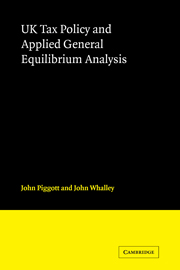Book contents
- Frontmatter
- Contents
- PREFACE
- ACKNOWLEDGEMENTS
- INTRODUCTION AND SUMMARY OF STUDY
- PART I The General Equilibrium Model of the UK – Structure, Data and Model Solution.
- PART II Empirical Analysis of the UK Tax/Subsidy System Using the General Equilibrium Model
- SUMMARY AND CONCLUSIONS
- APPENDIX A Structure of the Basic Variant Model
- APPENDIX B Notes to Tables Appearing in Chapter 5
- APPENDIX C Notes on Programming and Computation
- BIBLIOGRAPHY
SUMMARY AND CONCLUSIONS
Published online by Cambridge University Press: 04 August 2010
- Frontmatter
- Contents
- PREFACE
- ACKNOWLEDGEMENTS
- INTRODUCTION AND SUMMARY OF STUDY
- PART I The General Equilibrium Model of the UK – Structure, Data and Model Solution.
- PART II Empirical Analysis of the UK Tax/Subsidy System Using the General Equilibrium Model
- SUMMARY AND CONCLUSIONS
- APPENDIX A Structure of the Basic Variant Model
- APPENDIX B Notes to Tables Appearing in Chapter 5
- APPENDIX C Notes on Programming and Computation
- BIBLIOGRAPHY
Summary
In this study we report on a model of the UK economy and tax system which we have used to provide a numerical appraisal of the main impacts of the UK tax/subsidy system. With the basic variant of the model, we concentrate on the distorting effects of taxes and subsidies within a static full employment neo-classical general equilibrium framework, and calculate the resource allocation and distributional effects of alternative tax policy packages. We then consider a sequence of model extensions incorporating intertemporal and labour supply distortions due to taxes, and public good equilibria. In Part I of the study we outline the methods that we used. Both general and particular features are described, along with the functions and parameter values we use. We also summarize the data which give us estimates of tax and subsidy parameters for the model.
The main method of analysis we employ is counterfactual equilibrium analysis. We adopt an assumption that the UK economy achieves an equilibrium in the presence of existing tax/subsidy policies. We use data for a single year drawn from national accounts and other sources which we extend and transform into a form which is consistent with the equilibrium conditions of the model; this we term our benchmark equilibrium. We generate parameter values for the functions in the model such that we can replicate the benchmark equilibrium observation as a model equilibrium solution. The counterfactual analysis then involves the introduction of alternative policy regimes into the model.
- Type
- Chapter
- Information
- UK Tax Policy and Applied General Equilibrium Analysis , pp. 305 - 307Publisher: Cambridge University PressPrint publication year: 1985



